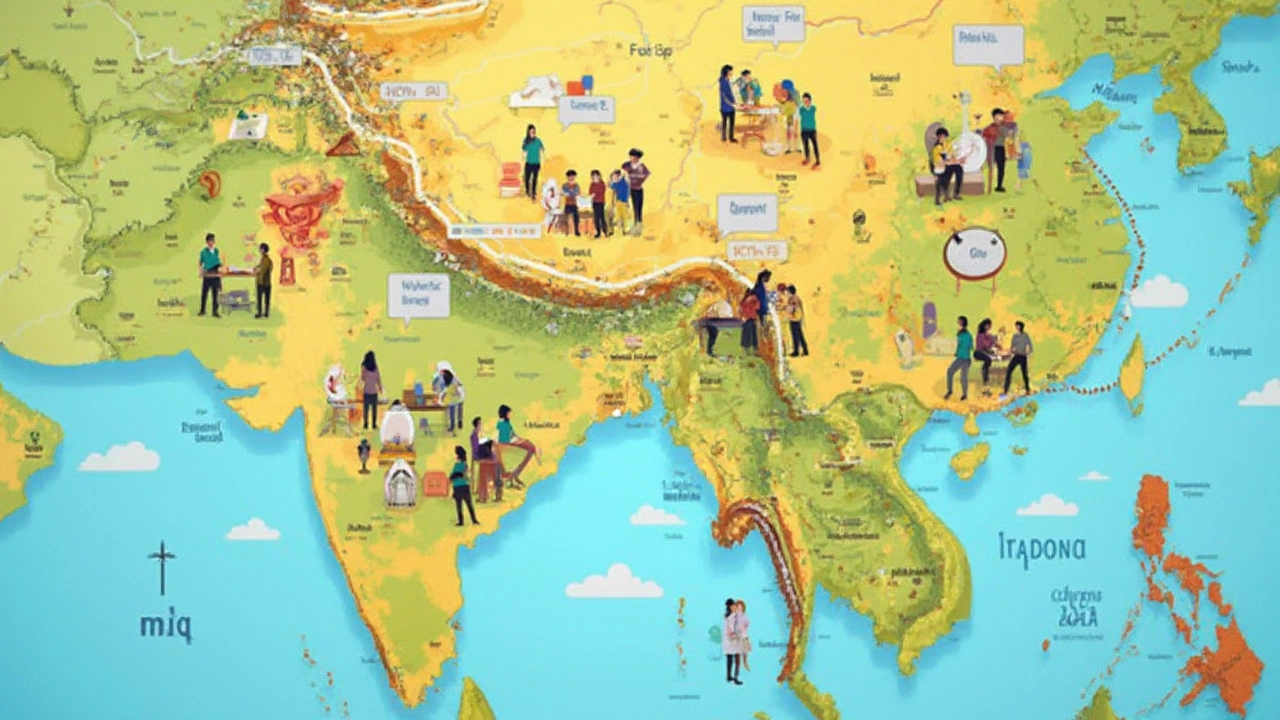Apr
21

- by Dhruv Ainsley
- 0 Comments
Have you ever wondered just how many kids are studying under the CBSE board in India today? The numbers will probably surprise you. The latest CBSE stats show that over 24 lakh students appeared for the Class 10 and Class 12 board exams in 2024. That’s just for those two grades. If you count everyone from primary to senior secondary, CBSE's student base crosses 2.7 crore—that’s around 27 million students!
This number hasn’t stayed flat. Every year, CBSE keeps adding more kids as new schools join up and families pick the syllabus for its focus on English, science, and maths. You might notice your local neighborhood has at least one school with a CBSE banner. In fact, over 28,000 schools inside India and nearly 250 schools outside India are affiliated with CBSE as of 2024.
Getting a sense of these numbers isn’t just for trivia. It helps parents see just how much support, study material, and peer network is available for their kids. It also explains why CBSE board exam results make headline news and why seat crunch during admissions is a real thing each year.
- CBSE Student Numbers: The Big Picture
- Why CBSE Keeps Growing
- Gender and Regional Patterns
- Staying Updated and What It Means for You
CBSE Student Numbers: The Big Picture
When people talk about the CBSE board, they’re talking about a giant in the Indian education scene. As of 2024, the Central Board of Secondary Education is connected to more than 28,500 schools in India and roughly 250 schools in 28 other countries. With this reach, the number of CBSE students in India is astounding—over 27 million if you count everyone from tiny first graders to stressed-out Class 12 kids.
If you want to break down those numbers a bit, check out the board exam stats. In 2024, more than 16.9 lakh (1.69 million) students appeared for the CBSE Class 10 exams and roughly 1.6 million for Class 12. These numbers were even higher than in 2023, showing a steady climb every year.
| Year | Class 10 Students | Class 12 Students | Total Schools (India) |
|---|---|---|---|
| 2022 | 20.9 lakh | 14.4 lakh | 26,000+ |
| 2023 | 21.8 lakh | 16.1 lakh | 27,000+ |
| 2024 | 22.3 lakh | 16.9 lakh | 28,500+ |
Now, these are just the board exam years. If you include all students from Nursery to Class 12, the numbers become even bigger. This is why CBSE influences so many kids’ lives across India and worldwide. The steady rise also means the board keeps updating its study materials and exam patterns to keep up with the latest education trends.
If you’re curious, the board usually releases detailed stats after every exam season. Their official site often has yearly reports breaking down the total number of students by class, gender, and location—super handy for anyone trying to spot education trends or plan ahead for school admissions.
Why CBSE Keeps Growing
The CBSE board isn’t just popular—it’s actually expanding every single year. The reason? It ticks off stuff that parents, students, and even schools are looking for. For starters, CBSE focuses a lot on English and STEM subjects, which fit straight into entrance exams for colleges like engineering and medical. That gives students a jump start for the future.
Let’s talk straight numbers—between 2015 and 2024, the count of CBSE-affiliated schools shot up from about 17,500 to over 28,000 in India. That’s a massive leap in less than a decade! And every time new schools join CBSE, the student count spikes. Here’s how the growth played out for recent board exams:
| Exam Year | Class 10 Students | Class 12 Students |
|---|---|---|
| 2021 | 21.5 lakh | 14.3 lakh |
| 2022 | 21.1 lakh | 14.4 lakh |
| 2023 | 21.8 lakh | 16.9 lakh |
| 2024 | 22.1 lakh | 18.3 lakh |
Another big pull is the recognition. CBSE results are valid just about everywhere in India and even in some foreign universities. So, students aren’t stuck when families move around. The syllabus is also more centralized—the same textbooks, same format—so transfers between cities don’t leave kids behind.
- CBSE textbooks (from NCERT) make self-study manageable. Past question papers and sample papers are easy to find online.
- Lots of competitive exams like JEE and NEET follow the CBSE pattern, so students stay ahead without needing a different coaching system.
- Even international students (like in the Middle East and Southeast Asia) are jumping into CBSE, with nearly 250 overseas schools now on the list.
If you’re wondering why you keep hearing about CBSE, it’s because every new feature or policy brings in more students and schools. The board is always tweaking the curriculum to match trends—coding, AI, and vocational skills aren’t extras anymore; they’re built right in now.

Gender and Regional Patterns
When you break down the CBSE student numbers by gender, things get interesting quick. In the 2024 board exams, girls made up about 46% of the candidates and boys covered a bit more than half. Even though boys are still a little ahead in total numbers, the gap is shrinking every single year. For instance, girls outperformed boys in overall pass percentage yet again—94.25% for girls as compared to 92.27% for boys in the Class 10 results.
If you look at regional trends, you’ll notice CBSE is the first choice in many big cities—Delhi, Bengaluru, Mumbai, Chennai, you name it. Northern India sees the biggest chunk of students enrolled under CBSE, with states like Uttar Pradesh and Delhi topping the charts for registrations. Some northeast states and rural zones still mostly follow their state boards, but CBSE's reach is growing fast even there thanks to new schools and better transport links.
Here’s a quick look at the state-wise registration numbers for the 2024 board exams:
| State/Region | Approximate Students (Class 10 & 12) |
|---|---|
| Uttar Pradesh | 3,30,000 |
| Delhi NCR | 2,10,000 |
| Maharashtra | 1,50,000 |
| Kerala | 95,000 |
| Northeast States | 60,000 |
One more thing—within the CBSE system, there are dedicated efforts to narrow the gender gap. From special scholarships for girl students to campaigns like Beti Bachao Beti Padhao, the board is trying to create a level playing field.
For families picking a board, knowing these gender and regional trends can help make the right call. You’ll see where your kid stands among peers and what kind of support—like scholarships or events—they might have access to based on where you live or their background.
Staying Updated and What It Means for You
If you’re part of the CBSE world—whether you’re a student, parent, or teacher—keeping up with the latest updates is pretty important. The CBSE board rarely stands still. From exam pattern changes to new subjects, migration rules, and digital tools, something always gets tweaked almost every year.
For instance, in 2024, CBSE introduced more competency-based questions in board exams, and even released sample papers and marking schemes online months ahead. No more last-minute surprises if you’re following official notifications.
If you want to stay on top of things, use these simple tricks:
- Check the official CBSE website weekly (cbse.gov.in). Don’t just rely on viral WhatsApp forwards—they often get things wrong.
- Pay attention to major circulars about exam dates, syllabus tweaks, and results. A lot of this makes the news, but always cross-check with the source.
- Join your school’s communication groups—teachers usually send out the main updates fast.
- For parents, follow CBSE's verified social media handles on Twitter or Facebook so you don’t miss important reminders.
This level of awareness does more than just beat stress. Every year, when exam dates shuffle or registration windows shift, those who track updates avoid panic. Plus, with CBSE expanding digital tools like DigiLocker for marksheets, students who follow updates get their results faster and safer than those waiting in queues at school.
| Update Category | How Often It Changes | Where to Find |
|---|---|---|
| Exam Schedules | Yearly/occasionally delayed | CBSE website, school noticeboard |
| Syllabus Changes | Every 1-2 years | CBSE Academic portal |
| Paper Pattern | Almost every year | Sample papers, official PDFs |
| Results Release | Annually | DigiLocker, official portals |
With millions of CBSE students out there, a little vigilance makes a big difference. The board’s scale means small announcements matter for lots of people. If you keep your eyes open and follow a handful of official sources, you’ll always know exactly what’s going on, instead of scrambling at the last minute.





